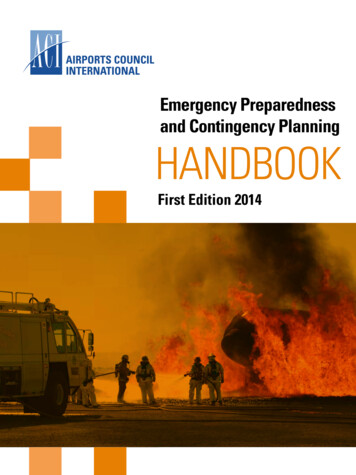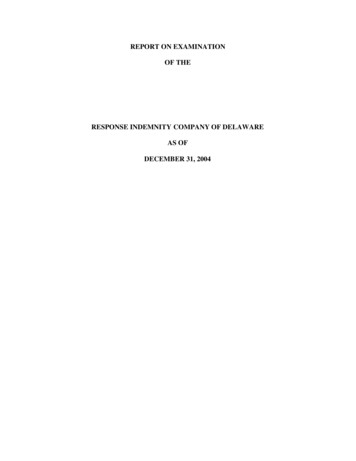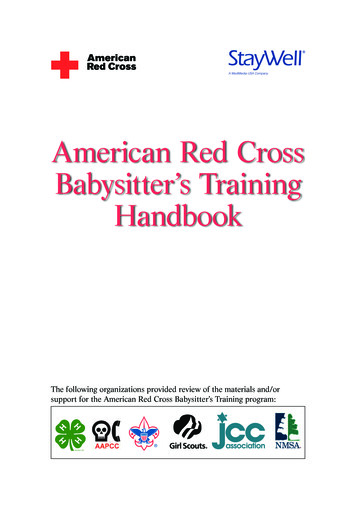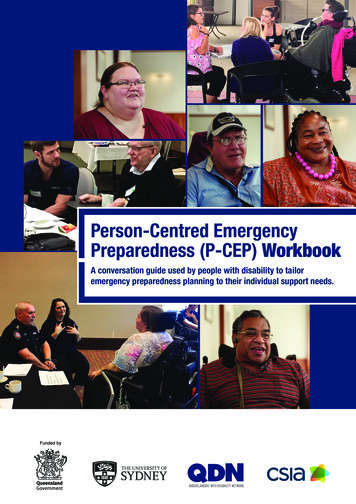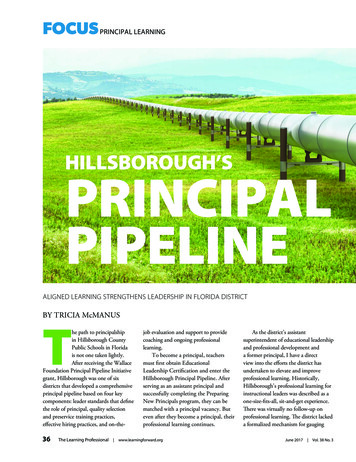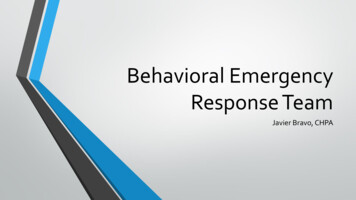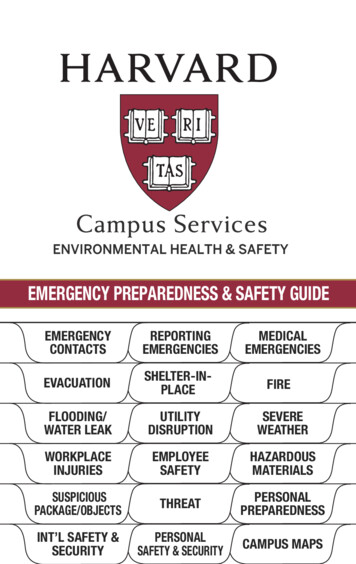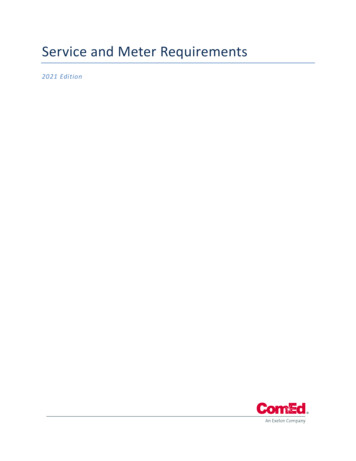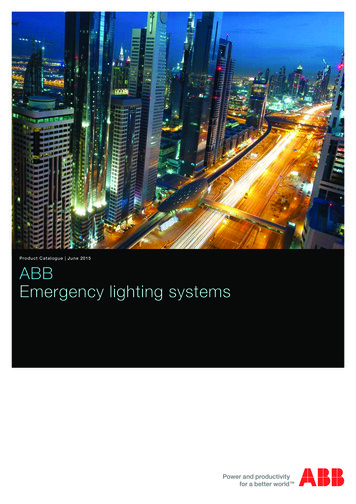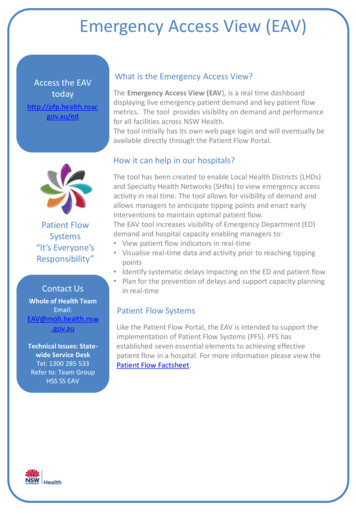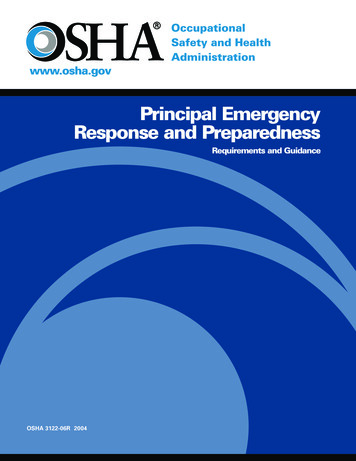
Transcription
Principal EmergencyResponse and PreparednessRequirements and GuidanceOSHA 3122-06R 2004
Employers are responsible for providing a safe andhealthy workplace for their employees. OSHA’s roleis to promote the safety and health of America’sworking men and women by setting and enforcingstandards; providing training, outreach and education;establishing partnerships; and encouraging continualimprovement in workplace safety and health.This publication provides a general overview of aparticular standards-related topic. This publicationdoes not alter or determine compliance responsibilities which are set forth in OSHA standards, and theOccupational Safety and Health Act. Moreover,because interpretations and enforcement policy maychange over time, for additional guidance on OSHAcompliance requirements, the reader should consultcurrent administrative interpretations and decisionsby the Occupational Safety and Health ReviewCommission and the courts.Material contained in this publication is in the publicdomain and may be reproduced, fully or partially,without permission. Source credit is requested butnot required.This information will be made available to sensoryimpaired individuals upon request. Voice phone:(202) 693-1999; teletypewriter (TTY) number: 1-877889-5627.
Principal Emergency Response and PreparednessRequirements and GuidanceOccupational Safety and Health AdministrationU.S. Department of LaborOSHA 3122-06R2004
ContentsIntroduction . 1Background . 1Using This Publication. 2Publication Organization . 3I.General Industry (29 CFR 1910) Requirements for Emergency Response and Preparedness. 4A.General Requirements for Workplaces . 41.29 CFR 1910.36 Design and construction requirements for exit routes. 42.29 CFR 1910.37 Maintenance, safeguards, and operational features for exit routes. 43.29 CFR 1910.151 Medical services and first aid . 54.29 CFR 1910.157 Portable fire extinguishers. 65.29 CFR 1910.165 Employee alarm systems . 7B.Additional Requirements for Workplaces Referenced in Other Requirements . 81.29 CFR 1910.38 Emergency action plans. 82.29 CFR 1910.39 Fire prevention plans. 9C.Additional Requirements for Specific Workplaces/Operations. 91.29 CFR 1910.66 Powered platforms for building maintenance. 92.29 CFR 1910.111 Storage and handling of anhydrous ammonia . 103.29 CFR 1910.119 Process safety management (PSM) of highly hazardouschemicals . 114.29 CFR 1910.120 Hazardous waste operations and emergency response;paragraphs (b), Safety and health program, through (o), New technology programs. 125.29 CFR 1910.120, paragraph (p) Certain operations conducted under theResource Conservation and Recovery Act of 1976 (RCRA). 136.29 CFR 1910.120, paragraph (q), Emergency response to hazardous substancereleases . 147.29 CFR 1910.124 General requirements for dipping and coating operations. 158.29 CFR 1910.146 Permit-required confined spaces . 169.29 CFR 1910.156 Fire brigades . 1710. 29 CFR 1910.262 Textiles . 1811. 29 CFR 1910.266 Logging operations. 1812. 29 CFR 1910.268 Telecommunications . 1913. 29 CFR 1910.269 Electric power generation, transmission and distribution. 1914. 29 CFR 1910.272 Grain handling facilities . 2015. 29 CFR 1910 Subpart T Diving Operations(29 CFR 1910.104 Scope and application,1910.410 Qualification of dive team,1910.420 Safe practice manual,1910.421 Pre-dive procedures, and1910.422 Procedures during dive) . 21
16.17.18.19.20.21.22.23.24.25.26.27.28.D.II.29 CFR 1910.1003 13 Carcinogens (4-Nitrobiphenyl, etc.),1910.1004 alpha-Naphthylamine,1910.1006 Methyl chloromethyl ether,1910.1007 3,3’-Dichlorobenzidine (and its salts),1910.1008 bis-Chloromethyl ether,1910.1009 beta-Naphthylamine,1910.1010 Benzidine,1910.1011 4-Aminodiphenyl,1910.1012 Ethyleneimine,1910.1013 beta-Propiolactone,1910.1014 2-Acetylaminofluorene,1910.1015 4-Dimethylaminoazobenzene,1910.1016 N-Nitrosodimethylamine . 2229 CFR 1910.1017 Vinyl chloride . 2329 CFR 1910.1027 Cadmium . 2429 CFR 1910.1028 Benzene . 2529 CFR 1910.1029 Coke oven emissions . 2629 CFR 1910.1044 1,2-dibromo-3-chloropropane. 2629 CFR 1910.1045 Acrylonitrile. 2729 CFR 1910.1047 Ethylene oxide. 2829 CFR 1910.1048 Formaldehyde . 2829 CFR 1910.1050 Methylenedianiline . 2929 CFR 1910.1051 1,3-Butadiene . 3029 CFR 1910.1052 Methylene Chloride . 3129 CFR 1910.1450 Occupational exposure to hazardous chemicals in laboratories. 32Requirements that Support Emergency Response and Preparedness . 321.29 CFR 1910.132 General requirements (Personal Protective Equipment) . 322.29 CFR 1910.134 Respiratory protection . 333.29 CFR 1910.1000 Air contaminants . 344.29 CFR 1910.1030 Bloodborne pathogens . 355.29 CFR 1910.1200 Hazard communication . 35Shipyard Employment (29 CFR 1915) Requirements for Emergency Response & Preparedness. 37A.General Requirements for Workplaces . 371.29 CFR 1915.52 Fire prevention . 372.29 CFR 1915.98 First aid. 37B.Additional Requirements for Workplaces Referenced in Other Requirements . 38C.Additional Requirements for Specific Workplaces/Operations. 381.29 CFR 1915.12 Diving Operations. 382.29 CFR 1915.1003 13 Carcinogens (4-Nitrobiphenyl, etc.),1915.1004 alpha-Naphthylamine,1915.1006 Methyl chloromethyl ether,1915.1007 3,3’-Dichlorobenzidine (and its salts),1915.1008 bis-Chloromethyl ether,
3.4.5.6.7.8.9.10.11.12.D.III.IV.1915.1009 beta-Naphthylamine,19100.1010 Benzidine,1910.1011 4-Aminodiphenyl,1915.1012 Ethyleneimine,1910.1013 beta-Propiolactone,1910.1014 2-Acetylaminofluorene,1915.1015 4-Dimethylaminoazobenzene, and/or1915.1016 N-Nitrosodimethylamine. . 3829 CFR 1915.1017 Vinyl chloride . 3829 CFR 1915.1027 Cadmium . 3829 CFR 1915.1028 Benzene . 3829 CFR 1915.1044 1,2-dibromo-3-chloropropane. 3929 CFR 1915.1045 Acrylonitrile. 3929 CFR 1915.1047 Ethylene oxide. 3929 CFR 1915.1048 Formaldehyde . 3929 CFR 1915.1050 Methylenedianiline . 3929 CFR 1915.1052 Methylene Chloride . 3929 CFR 1915.1450 Occupational exposure to hazardous chemicals in laboratories. 39Requirements that Support Emergency Response and Preparedness . 391.29 CFR 1915.152 General requirements (Personal Protective Equipment) . 392.29 CFR 1915.154 Respiratory protection . 403.29 CFR 1915.1000 Air contaminants . 404.29 CFR 1915.1030 Bloodborne pathogens . 415.29 CFR 1915.1200 Hazard communication . 41Marine Terminals (29 CFR 1917) Requirements for Emergency Response and Preparedness. 42A.General Requirements for Workplaces . 421.29 CFR 1917.22 Hazardous cargo. 422.29 CFR 1917.23 Hazardous atmospheres and substances. 423.29 CFR 1917.26 First aid and lifesaving facilities. 434.29 CFR 1917.30 Emergency action plans. 435.29 CFR 1917.128 Signs and marking . 44B.Additional Requirements for Workplaces Referenced in Other Requirements . 44C.Additional Requirements for Specific Workplaces/Operations. 441.29 CFR 1917.1 Scope and applicability (29 CFR 1910 Subpart T CommercialDiving applies to marine terminals) . 442.29 CFR 1917.73 Termination facilities handling menhaden and similar species offish . 44D.Requirements that Support Emergency Response and Preparedness . 451.29 CFR 1917.25 Fumigants, pesticides, insecticides and hazardous preservatives . 452.29 CFR 1917.28 Hazard communication . 463.29 CFR 1917.92 Respiratory protection . 464.29 CFR 1917.95 Other protective measures. 46Longshoring (29 CFR 1918) Requirements for Emergency Response and Preparedness. 47A.General Requirements for Workplaces . 47
1.2.3.4.V.29 CFR 1918.93 Hazardous atmospheres and substances. 4729 CFR 1918.94 Ventilation and atmospheric conditions . 4729 CFR 1918.97 First aid and lifesaving facilities. 4829 CFR 1918.100 Emergency action plans. 48B.Additional Requirements for Workplaces Referenced in Other Requirements . 50C.Additional Requirements for Specific Workplaces/Operations. 491.29 CFR 1918.1 Scope and application(29 CFR 1910 Subpart T Commercial Diving applies to marine terminals) . 49D.Requirements that Support Emergency Response and Preparedness . 491.29 CFR 1918.90 Hazard communication . 492.29 CFR 1918.102 Respiratory protection . 49Construction (29 CFR 1926) Requirements for Emergency Response and Preparedness . 50A.General Requirements for Workplaces . 501.29 CFR 1926.23 First aid and medical attention, and1926.50 Medical services and first aid. . 502.29 CFR 1926.24 Fire protection and prevention,1926.150 Fire protection, and1926.151 Fire prevention. 503.29 CFR 1926.34 Means of egress. 51B.Additional Requirements for Workplaces Referenced in Other Requirements . 521.29 CFR 1926.35 Employee emergency action plans . 52C.Additional Requirements for Specific Workplaces/Operations. 521.CFR 29 1926.60 Methylenedianiline . 522.CFR 29 1926.64 Process safety management (PSM) of highly hazardouschemicals . 533.29 CFR 1926.65 Hazardous waste operations and emergency response,paragraphs (b) Safety and health program through (o) New technology programs. 534.29 CFR 1926.65, paragraph (p) Certain operations conducted under the ResourceConservation and Recovery Act of 1976 (RCRA) . 545.29 CFR 1926.65, paragraph (q) Emergency response to hazardous substancereleases . 546.29 CFR 1926.651 Specific excavation requirements . 547.29 CFR 1926.800 Underground construction. 548.29 CFR 1926.950 General requirements (Power Transmission and Distribution) . 559.29 CFR 1926 Subpart T Diving Operations(29 CFR 1926.1071 Scope and application,1926.1076 Qualification of dive team,1926.1080 Safe practice manual,1926.1081 Pre-dive procedures, and1926.1082 Procedures during dive) . 5610. 29 CFR 1926.1103 13 Carcinogens, etc. (4-Nitrobiphenyl, etc.),1926.1104 alpha-Naphthylamine,1926.1106 Methyl chloromethyl ether,1926.1107 3, 3’-Dichlorobenzidine (and its salts),1926.1108 bis-Chloromethyl ether,1926.1109 beta-Naphthylamine,
11.12.13.14.15.16.17.18.19.D.VI.1926.1110 Benzidine,1926.1111 4-Aminodiphenyl,1926.1112 Ethyleneimine,1926.1113 beta-Propiolactone,1926.1114 2-Acetylaminofluorene,1926.1115 4-Dimethylaminoazobenzene, and/or1926.1116 N-Nitrosodimethylamine . 5629 CFR 1926.1117 Vinyl chloride . 5629 CFR 1926.1127 Cadmium . 5729 CFR 1926.1128 Benzene . 5729 CFR 1926.1129 Coke oven emissions . 5729 CFR 1926.1144 1,2-dibromo-3-chloropropane. 5729 CFR 1926.1145 Acrylonitrile. 5829 CFR 1926.1147 Ethylene oxide. 5829 CFR 1926.1148 Formaldehyde . 5829 CFR 1926.1152 Methylene Chloride . 58Requirements that Support Emergency Response and Preparedness . 581.29 CFR 1926.28 Personal protective equipment and 1926.95 Criteria for personalprotective equipment . 582.29 CFR 1926.55 Gases, vapors, fumes, dusts, and mists . 593.29 CFR 1926.59 Hazard communication . 594.29 CFR 1926.103 Respiratory protection . 59Agriculture (29 CFR 1928) Requirements for Emergency Response and Preparedness . 60A.General Requirements for Workplaces . 601.29 CFR 1928.21 Applicability of Standards in 29 CFR Part 1910. 60Additional Online Emergency Assistance Information . 61OSHA . 61Other Sources of Information . 61OSHA Assistance. 61Safety and Health Program Management Guidelines. 61State Programs . 62Consultation Services. 62Voluntary Protection Programs (VPP). 63Strategic Partnership Program . 63Alliance Program . 63OSHA Training and Education . 64Information Available Electronically . 64OSHA Publications. 64Contacting OSHA . 64OSHA Regional Offices. 66
IntroductionThe importance of an effective workplace safety and health program cannot be overemphasized.There are many benefits from such a program, including increased productivity, improvedemployee morale, reduced absenteeism and illness, and reduced workers’ compensation rates.Unfortunately, workplace accidents and illnesses still occur in spite of efforts to prevent them,and proper planning is necessary to effectively respond to emergencies.Several Occupational Safety and Health Administration (OSHA) standards explicitly requireemployers to have emergency action plans for their workplaces. Emergency preparedness is awell-known concept in protecting workers’ safety and health. To help employers, safety andhealth professionals, training directors, and others, the OSHA requirements for emergencies arecompiled and summarized in this booklet.This publication provides a generic, non-exhaustive overview of OSHA standards foremergencies. It is not intended to alter or determine compliance responsibilities in OSHAstandards or the Occupational Safety and Health Act of 1970. Please review the current OSHAstandards applicable to your work operations to ensure your compliance.NOTE: The Americans with Disabilities Act (ADA) imposes specific obligations on employersrelative to employment of individuals with disabilities. The United States Equal EmploymentOpportunity Commission’s website provides employer resources for addressing ADArequirements in private workplaces, including “Enforcement Guidance on ReasonableAccommodations.” The Job Accommodations Network publication Emergency EvacuationProcedures for Employees with Disabilities provides planning information and resources onemergency procedures for employees with disabilities.BackgroundThe U.S. Congress passed the Superfund Amendments and Reauthorization Act (SARA) in 1986.This legislation included the Emergency Planning and Community Right to Know Act (Title III),which laid the foundation for communities to prepare for and respond to emergency incidentsinvolving hazardous substances. Title III also requires employers to assist in planning and toprovide accurate information about the hazardous substances or chemicals they control.In 1989, OSHA issued a final rule on Hazardous Waste Operations and Emergency Response(HAZWOPER) to work hand-in-hand with SARA Title III. OSHA’s rule, 29 CFR 1910.120,establishes safety and health requirements for employers for the protection of employees andrequires the development of an emergency response plan. This plan is to be integrated withlocal, state, and Federal agency plans for local community emergency preparedness.A second “significant” emergency planning law was enacted in 1990. The Clean Air ActAmendments (CAAA) gave the Environmental Protection Agency (EPA) and OSHA moreresponsibilities for preventing major chemical emergencies. In response to this legislation,OSHA issued the Process Safety Management (PSM) of Highly Hazardous Chemicals standard1
(29 CFR 1910.119) in 1992. The standard requires employers to establish a PSM program toprevent major chemical workplace emergencies and to implement an emergency action plan.The requirements of the HAZWOPER and PSM standards are provided in this publication. Inaddition, the publication includes emergency action plan and fire prevention plan requirementsand emergency planning and response requirements in many other OSHA standards. In order tohave an effective safety and health program, it is necessary to develop and implement emergencypreparedness and response requirements that are applicable to the workplace.The 26 states that operate OSHA-approved state plan programs set and enforce standards, suchas HAZWOPER and PSM, and the other emergency planning and response requirements, whichare identical to or at least as effective as Federal OSHA standards. While this publication canprovide useful guidance to all employers and employees, if you are in a state with an OSHAapproved state program, you should contact the state program for specific compliancerequirements.Please note that the EPA has Risk Management Program (RMP) and Community Right-to-Knowregulations that address releases of dangerous chemicals. Information is available on the EPA’swebsite at http://www.epa.gov/epaoswer/hotline/rmp.htm.Using This PublicationTo use this publication effectively, you should review the standards identified for your industrialsector(s) and determine if they apply to your workplace. Each standard listed in this publicationincludes a general description of the standard’s scope. Once you have determined whichstandards apply to your workplace, review the requirements and resources identified in thispublication for each applicable standard. To assist you in better understanding each standard,this publication summarizes the essential program, procedural, equipment, and trainingrequirements in each of the standards identified. The publication also provides online resources,including active Internet links, which discuss compliance information for implementing criticalrequirements. While viewing this online you can click on any of the highlighted words andphrases, and be linked to online materials that define or help clarify the word or phrase as it isused in the standard.Please note that, in developing this publication, the standards most applicable to emergencyresponse and preparedness were included. Standards that were deemed not directly or as likelyto apply to emergencies were not included. Therefore, while the majority of standards thatinclude emergency-related requirements are addressed in this document, other OSHA standardscould be applicable to a particular response action.2
Publication OrganizationThis publication is organized so that all standards for a particular industry are grouped together.The emergency-related requirements included in this publication are grouped in the followingsections: I. General Industry (29 CFR 1910), II. Shipyard Employment (29 CFR 1915),III. Marine Terminals (29 CFR 1917), IV. Longshoring (29 CFR 1918), V. Construction(29 CFR 1926), and VI. Agriculture (29 CFR 1928). Please note that a single employer could becovered by standards for more than one industry. For example, an employer in a manufacturingplant is primarily covered by 29 CFR 1910 but would be covered by 29 CFR 1926 in caseswhere employees are performing construction work such as erecting a new building ordemolishing an old structure.Within each group of industry standards, the standards are further organized into sections. Thesesections outline the emergency-related requirements as follows: General Requirements for WorkplacesThese standards are generally required of all workplaces within the industry. Everyemployer must comply with these requirements or the parallel state plan requirements,except where specifically exempted. Additional Requirements for Workplaces Referenced in Other RequirementsThe standards listed in this section are those that are applicable to the workplace whenemployer compliance is required by another OSHA standard. For example, a grainhandling facility employer is required by the grain handling facility standard (1910.272)to implement an emergency action plan meeting the requirements of 1910.38. [Note: Noadditional requirements for Shipyard Employment, Marine Terminals and Longshoringare referenced in other requirements.] Additional Requirements for Specific Workplaces/OperationsThe standards that cover specific workplaces, operations, or processes are listed in thissection. It is important to note that 29 CFR 1910.5(c) provides that these specificstandards shall prevail over any other general standard which might otherwise beapplicable to the same condition, practice, means, method, operation, or process. Thegeneral standards do apply, however, to the extent that none of the particular standardsare applicable. Requirements that Support Emergency Response and PreparednessIn addition to the emergency requirements contained in the sections above, this sectionincludes standards that are likely to be applicable in an emergency situation. In anychemical-related emergency, for example, the personal protective equipmentrequirements are likely to be applicable. Likewise, for emergencies involving injuredpersons, the requirements of the bloodborne pathogens standard may apply.3
I.General Industry (29 CFR 1910) Requirements forEmergency Response and PreparednessA. General Requirements for Workplaces1.29 CFR 1910.36 Design and construction requirements for exit routesThis standard establishes requirements for the proper design and co
29 CFR 1918.97 First aid and lifesaving facilities.48 4. 29 CFR 1918.100 Emergency action plans.48 B. Additional Requirements for Workplaces Referenced in Other Requirements.50 C. Additional Requirements for Specifi
